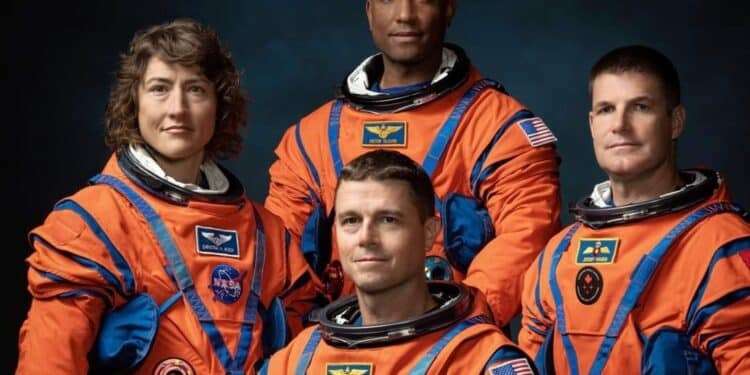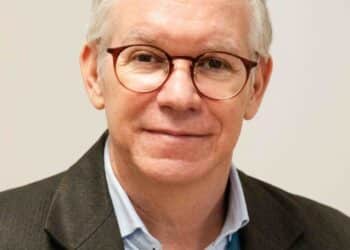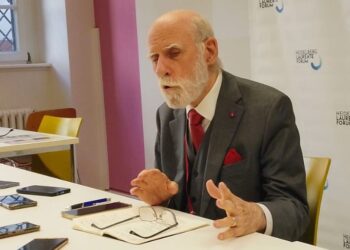The four-person team of three Americans and one Canadian will make history as the first people to travel to the moon in more than 50 years.
For the first time in more than 50 years, NASA has selected an astronaut crew to travel to the moon.
They are Victor Glover, the pilot; Christina Koch, a mission specialist; and Jeremy Hansen, another mission specialist. Reid Wiseman is the operation’s commander. The first three are pilots for NASA, and Mr. Hansen is a Canadian Space Agency employee.
“So am I excited?” Ms. Koch said during an event unveiling the crew at Ellington Field, a small airport used by NASA for training of astronauts. “Absolutely. But my real question is: are you excited?” The assembled crowd cheered in response.
A significant step in NASA’s Artemis mission is sending astronauts back to the moon’s surface to investigate the icy regions close to its south pole, where water ice can be found in the deep, dark craters. NASA aims to learn how to send people to Mars from the moon mission, and researchers anticipate using the information they gather to shed light on how the solar system came into being.
NASA administrator Bill Nelson declared, “Together, we are going—to the Moon, to Mars, and beyond.”
However, none of the four astronauts on the upcoming Artemis II mission will land on the moon.
Instead, the travelers will take a 10-day journey to swing around the moon and return to Earth. The trip is scheduled for late next year. It will be the first time humans have ventured more than a few hundred miles off the planet since the return of Apollo 17, NASA’s last moon mission, in 1972.
“It’s an exciting time for the Artemis people, no question about it,” Harrison Schmitt, the last surviving astronaut from Apollo 17, said in an interview. He added that many people did not “fully realize that we’re about three generations away from any experience with human beings being in deep space, and that’s probably the most important part of the mission.”
Dr. Schmitt, a former United States senator, said he was not necessarily surprised that it had taken so long. “I would say I’m disappointed,” he said. “A lot of things conspired to stop the Apollo program and to keep us from going back for quite a while.”
Astronauts in 2023 are very different from those of the moon race era. During the Apollo program, 24 astronauts flew to the moon, and 12 stepped on the surface. All of them were Americans, white men, many of whom were test pilots.
This time, the astronaut corps reflects a wider swath of society.
During the event, Mr. Wiseman said it said it was “awesome” to command a an international, diverse crew.
Mr. Glover was the commander of the first operational mission of SpaceX’s Crew Dragon to the International Station and was the first Black man to serve as a crew member on the orbiting outpost.
As a Canadian, Ms. Koch will be the first woman to venture beyond low-Earth orbit, and Mr. Hansen will be the first non-American to travel that far.
Mr. Hansen noted that the United States could have undertaken the Artemis missions by itself by instead chose to pull together an international collaboration with Canada and the European Space Agency. That agreement reserved a seat for a Canadian astronaut on Artemis II.
“All of Canada is grateful for that global mind set and that leadership,” Mr. Hansen said.
Mr. Wiseman said he wanted the moon missions “to bring our country together and the world together.
As the mission’s name indicates, Artemis II will be the second in NASA’s Artemis program. Artemis I launched last November as an uncrewed test of the Space Launch System, NASA’s giant new rocket, and the Orion astronaut capsule. The Orion spacecraft spent two weeks in orbit around the moon before returning to Earth, splashing down in the Pacific.
After years of delay — development of the rocket took longer than originally promised — the Artemis I mission progressed smoothly for the most part, although some problems occurred. The heat shield of Orion protected the spacecraft during re-entry into the Earth’s atmosphere, but more of it came off than had been expected.
With four astronauts aboard, Artemis II will allow a full check of the Orion’s life support systems. Then NASA officials will feel more confident in undertaking the longer, more complex Artemis III mission, including two astronauts landing near the south pole.
NASA is aiming for that first moon landing in late 2025, but the NASA inspector general predicted the mission would slip to 2026 or later. The Artemis III mission requires using Starship — the giant spacecraft being developed by SpaceX, Elon Musk’s rocket company — to take the two astronauts from a distant lunar orbit to the surface. The first test launch of Starship to space might take off in the coming weeks.
In the 1960s, the space race reflected the geopolitical jousting between the United States and the Soviet Union. There are some geopolitical echoes this time too. China is also aiming to send astronauts to the moon in the coming years.
But it is not just governments aiming for the moon now.
Yusaku Maezawa, a Japanese billionaire, has bought a trip on Starship that would loop around the moon similar to the trajectory that Artemis II will take. Dennis Tito, an entrepreneur who was the first space tourist to visit the International Space Station in 2001, and his wife, Akiko, have booked seats on a separate Starship trip around the moon.
Five decades ago, it would have been like a billionaire buying a Saturn V rocket, which propelled the Apollo astronauts to the moon.
Today, it seems almost inevitable that the footprints of tourists will crisscross the lunar surface in the years to come.
In an interview, Chris Hadfield, a Canadian astronaut who retired in 2013 after three trips to space, compared space travel to the early days of aviation. The wobbly craft that the Wright Brothers built in 1903 flew, but barely. But progress was fast. The first flight for KLM, the Dutch airline, was in 1920.
“Seventeen years from the Wright brothers to a profitable airline that’s still around,” Mr. Hadfield said.
He added that innovation had greatly reduced the cost of leaving Earth.
“You can see that the cost is going to keep coming down as the vehicles get better proven, and that’s going to increase the access and opportunity,” Mr. Hadfield said.
Dr. Schmitt offered some simple advice to the Artemis II astronauts: “Just enjoy it. “











